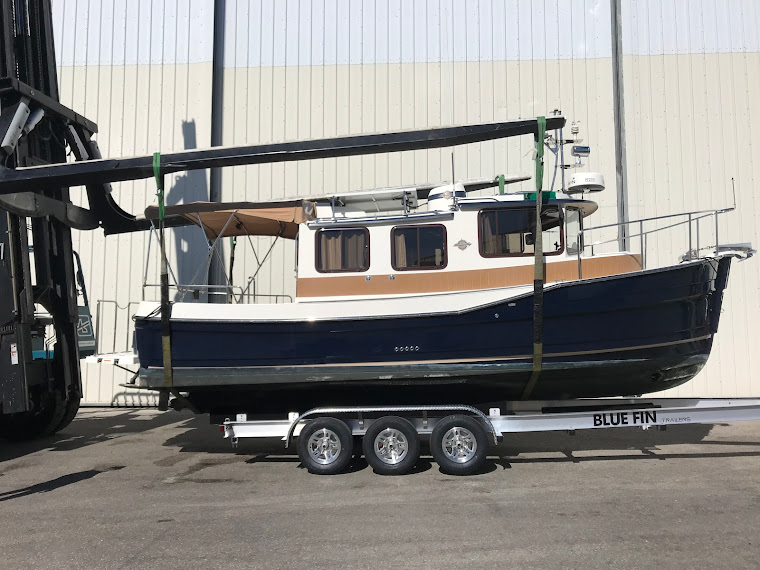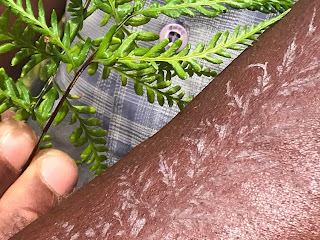Dominica
– the nature island
Dominica
is the perfect stop between the tempting treats of the French islands –
Guadalupe and Martinique. Not that there aren’t “treats” on Dominica,
fortunately, they generally contain less refined sugar. Although it is called
the “Nature Island” it could also be called the “Garden Island”. Fruit and edible plants grow just about
everywhere. We took several “tours” –
more accurately “endurance treks” with local guides both in Portsmouth in the
north and Rosseau in the south. (Our first with Martin was only 8 hours and the
second with Octavius – better known as Sea Cat – was 9 hours.) Along the route
between stops the guides would screech to a stop along the narrow winding road,
jump out and “harvest” something to taste.
These included items never before
seen to peel and sample – as well as the more familiar.
One guide gave us cacao
straight from the pod to suck on but the other took us to the Pointe Baptiste
Chocolate Factory where we saw all the steps that convert the fresh cocoa to
eating chocolate. Yes, it included
generous tasting and the opportunity to buy some for the boat. (After these
tours we deserved it!
At one point a
fellow group member suggested that the guides should perhaps be paying us to go
on these trips!) Our 8-hour trip started with a look at a rustic Bay Leaf
distillery. Who knew that bay leaf oil
was so useful and that extracting the oil was done commercially? We made a stop to tour a local garden and learn about typical plants and how to carry loads - on our heads!
 |
| thankfully my load was small |
On our next
stop we hiked into the Cold Soufriere – cold water bubbling from a deep
volcano. This is most unusual since most of the water that bubbles here is warm
to hot. There was a pool but we pressed on and did not swim there although it
is reputed to be a mineral rich healthy place for a dip.
Dominica
has nine volcanoes and the entire Caribbean has only 16 in total, so it is no
wonder that water bubbles in many places here in the water as well as on land.
At
a beach stop for local drinks and dominoes we got a peak at the Atlantic side
of the island and the red rocks which we visited after our lunch break.
The
red rocks are impressive mounds colored by the iron rich soil and eroding with
the effects of rain, wind, and ground water. They pose a distinct contrast to
the lush green of the surrounding hills, cliffs and peaks.
 |
| colorful plantings lined most roads - all local effort |
Finally,
we arrived at the Pointe Baptiste chocolate factory. This tiny operation is the
brain child of Alan Napier – grandson of the estate founders, Elma and Lennox.
He began the project mainly because he missed good eating chocolate when he
moved to Dominica. Cacao has been a
traditional crop here and used locally in a semi-processed form. These rolls of
chocolate have not been ground finely and tempered or mixed with sugar to
create an eating style chocolate but they are readily available in the market.
Grated and added to milk or water with a little spice and sugar they make a
very traditional hot chocolate drink. Alan Napier who gave us the tour of his
operation has gradually developed his operation to include state of the art
grinders, ovens, and a tempering machine.
All of this plus the drying sheds are tucked into a colorful corner of
his grandparents’ estate. Martin even took me for a peek at the original
“cottage” that his grandparents built – although much restored from hurricane
damage. The lush gardens surrounding it
make this an ideal vacation hideaway and fortunately it is available to rent!
(The perfect vacation next to a chocolate factory, above a beautiful beach on
an idyllic island.)
On our way back to the shore we stopped for a swim – a short hike into a pond that Martin told us would take 10 years off our age. This is one reason the locals are so healthy and live to great ages. (The oldest recorded person recently died here at the age of 126.) The hike, however, on slippery rocks – probably took back those 10 years in my case.
 |
| passing the ruins of a distillery on our way to the "pond" of youth |
Portsmouth
is a unique place for boaters. They have
organized to assist boats as they round the corner of the Cabrits until they
depart the bay. Most boats are greeted
by a colorfully painted skiff with a waving hello! We had arranged for Martin Providence to
assist us and he came out to guide us to one of the PAYS moorings suitable for
our boat. Then he graciously presented a huge bouquet of local flowers and
greens while we discussed what tours and “help” we might need.
The PAYS group offer to take away trash and
get laundry done as well as organize island tours to popular destinations. Besides the full day tour Martin took us on a
paddle up the Indian River – we opted to go in the morning in hopes of seeing
birds – so our stop at the bar in the jungle was without rum punch but Martin
took time to create origami like birds with rain forest leaves. And, we stopped to watch a green backed heron
on her nest.
Although
we didn’t need a guide, we enjoyed our tour of the local market on Saturday
morning. This bounty of local fruits and
veggies snakes along three streets overflowing the small covered market area
along the fish dock. Steve stood in line at the fish market but all the fish
was sold before he worked his way to the front. 8 Eastern Caribbean dollars for
a kilo of Mahi – less than $3 US for 2+ pounds!
Mother’s
Day found us at a potluck BBQ with 16 other boaters on shore at the PAYS
pavilion. A good chance to share plans and here stories on the adventures of
fellow boaters.
One
afternoon we walk/hiked up to the restored Fort Shirley which overlooks the
harbor in Portsmouth on the Cabrits.
This was a British fort to defend the island from the French. During the
early years of colonization, the island was controlled at different times by
both the French and British, but in the end the Brits prevailed so English is
the official language and cars drive on the left. However, many place names hearken back to the
French domination. The island is now
independent and has controlled its own destiny since 1978. Sadly, they have
also been a frequently a target of major hurricanes – most recently in 2017 –
Maria damaged 95% of the island roofs. Amazingly the green has returned
although evidence of the destruction is still easily seen with damaged
buildings, beheaded palms, and trees with loped off limbs.
The
way of life is pretty basic but there were lots of smiles and friendly faces in
spite of still recovering from the devastation brought by Maria. We were told
unemployment is high – some work off the island during the summer low tourist
season – but food is plentiful and there for the picking.
We
finally moved south to the capital city, Rosseau where Octavius (Sea Cat)’s
crew got us a mooring and whisked us off to tour the south.
Although there are
dinghy docks – many were damaged by the storm, so the water taxis picked us up
and delivered us back to our boat. Our
dinghy stayed on the boat!
 |
| catching a ride with Martin just like Sea Cat in Rosseau |
With
Sea Cat we made another whirlwind tour – including an hour-long hike around a
lake, a swim through a slot cannon, lunch, a vertical climb up Trafalgar Falls
for a dip in the HOT Water at the top, then a few more stops to see the
bubbling springs at Wooten Waven and view the sunset from the cliffs above
town. Sea Cat’s skill as a guide of the geriatric was tested as he monitored my
every step and literally pulled me up and nudged me back down the falls – but
the soak in the hot pool was worth the effort. (Big slippery rocks are not my
thing.)
On
both of our tours we were part of a small group. The high season ends with April so numbers
are lighter now and we enjoyed small groups – there were 6 of us on the tour
with Martin – two sailing vessels that came directly to the islands from
Norfolk with the North American ARC rally. With Sea Cat we were 5 – a group of
three from a catamaran who have sailed around the world with another ARC rally.
So, on both trips our time in the car was almost as interesting as our stops as
we heard stories from these adventurous sailors.
 |
| the reason they took this hike without me! |
 |
| push, pull, lift |
Our
final day in Dominica was just a little more relaxing – we started with a three-hour
wander in the old town – to see the museum, craft market, IGA and Fresh Market
grocery stories and enjoy the ambiance of the town – without any cruise ship
traffic. This was easy since the water taxi dropped us on the wharf and picked
us up.
In the afternoon Steve went diving with Diver Don and I snorkeled with
Bean – we visited the bubbles and cannons and the reef still recovering from
the storm of 2017. To end the afternoon, we sat in the hot water pool created
by an entrepreneur along the shore to capture the natural hot spring water
bubbling up into the sea. Oh yes, he also serves delightful rum drinks to enjoy
while soaking away the aches in tired muscles.
 |
| the happy Mr Bean! |
With
a few stiff joints we headed out early to return once again to the French
Caribbean – this time in Martinique.





























































































